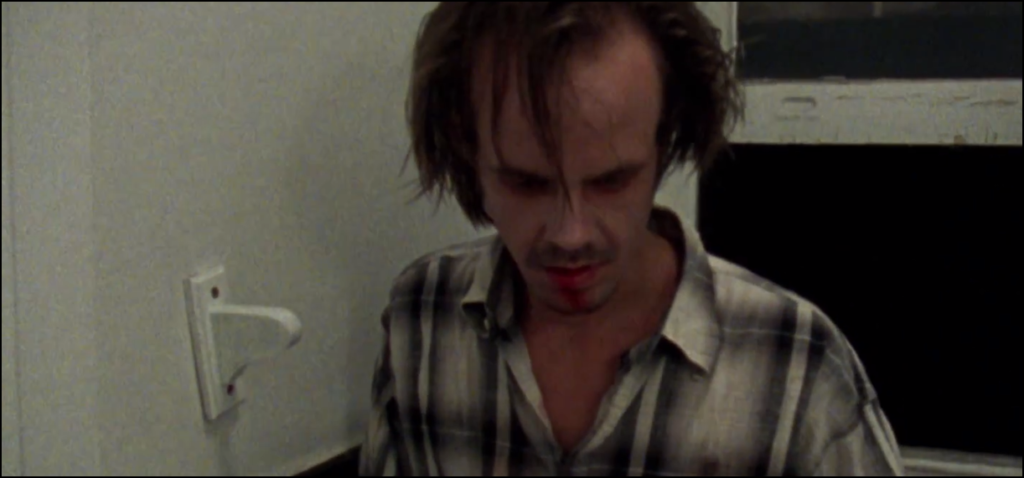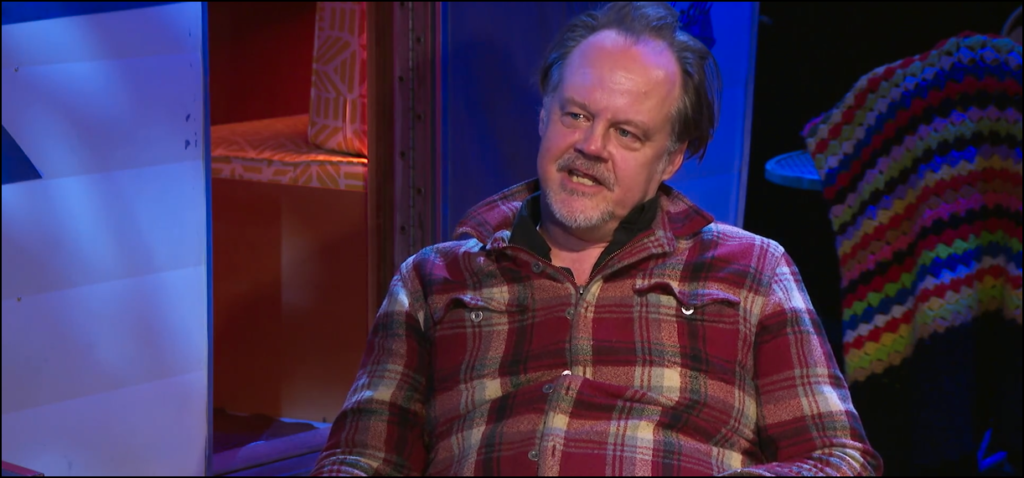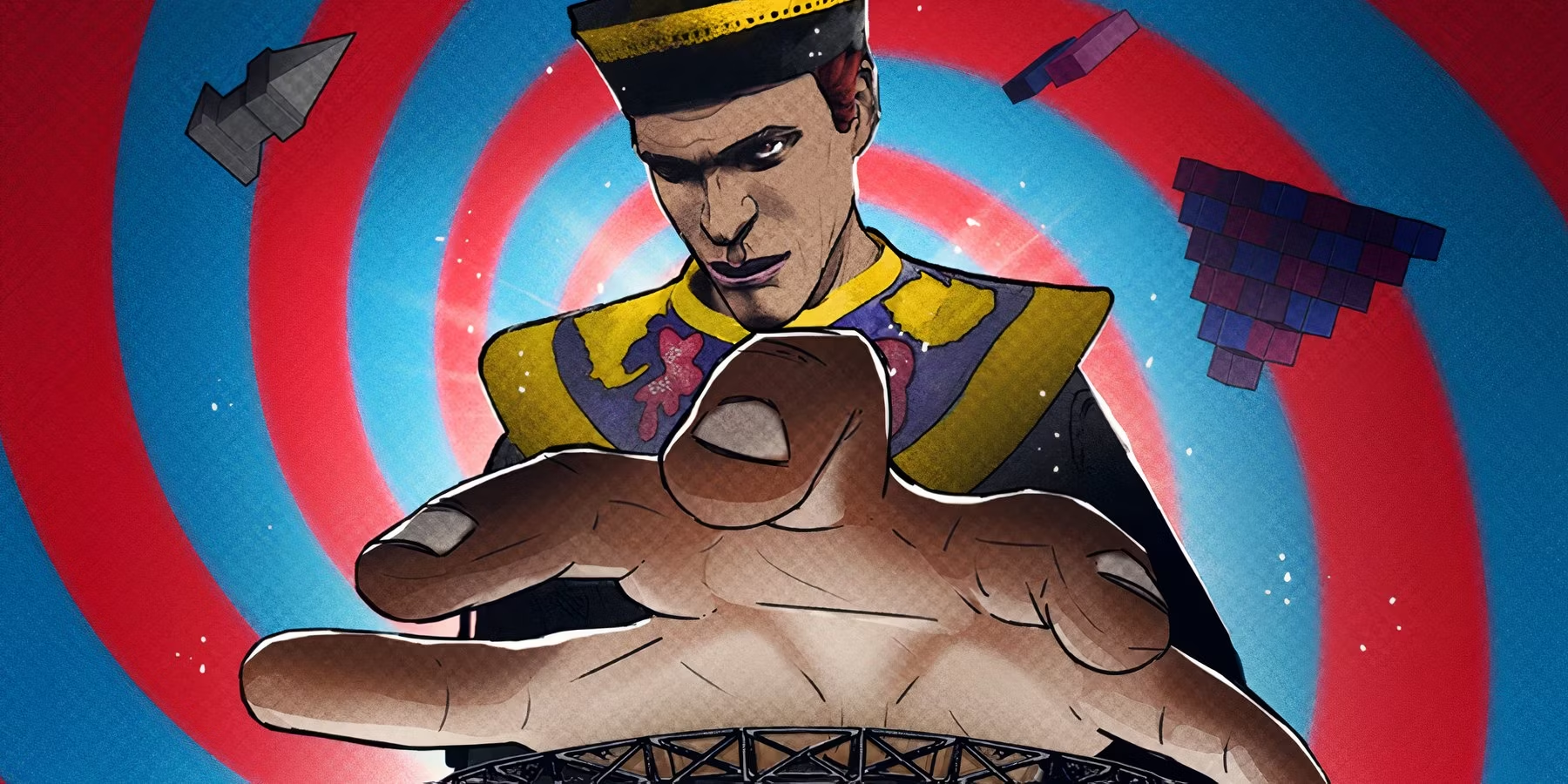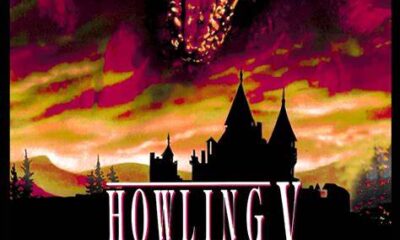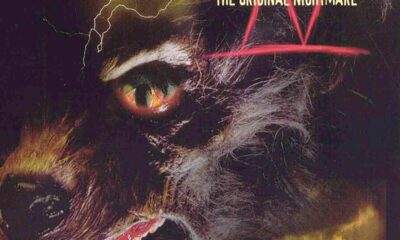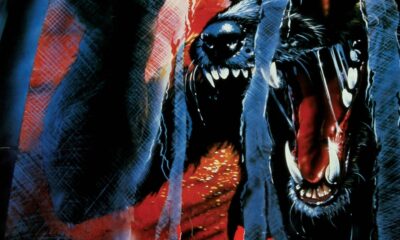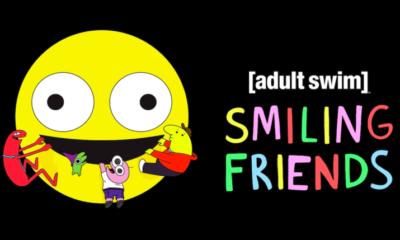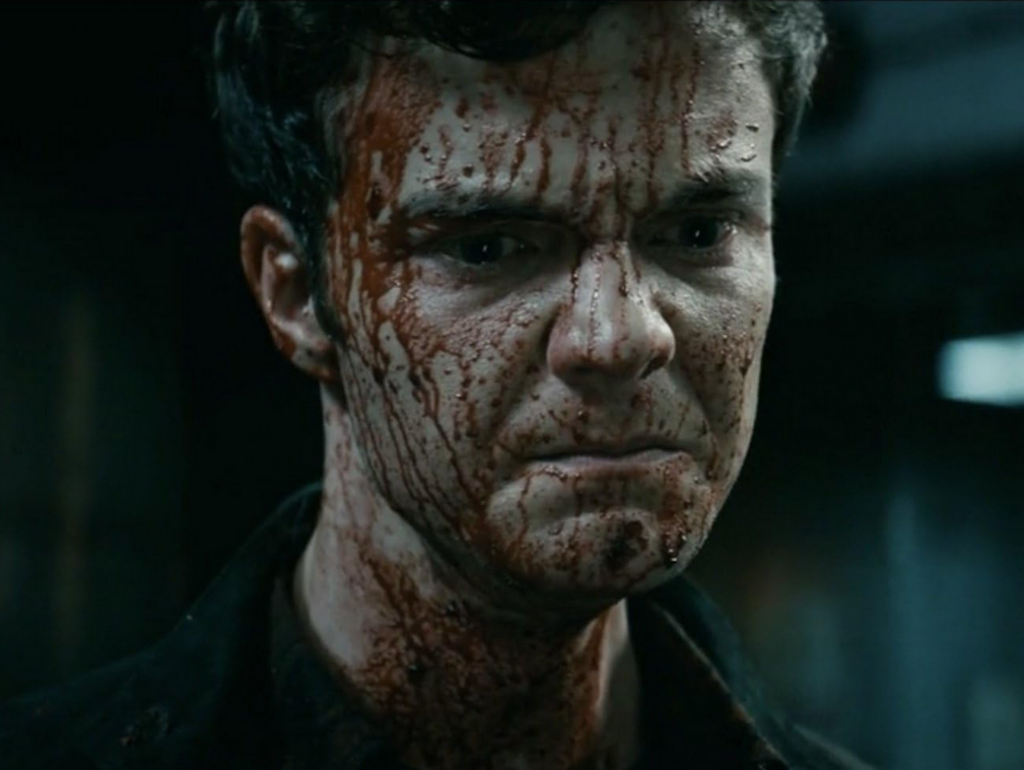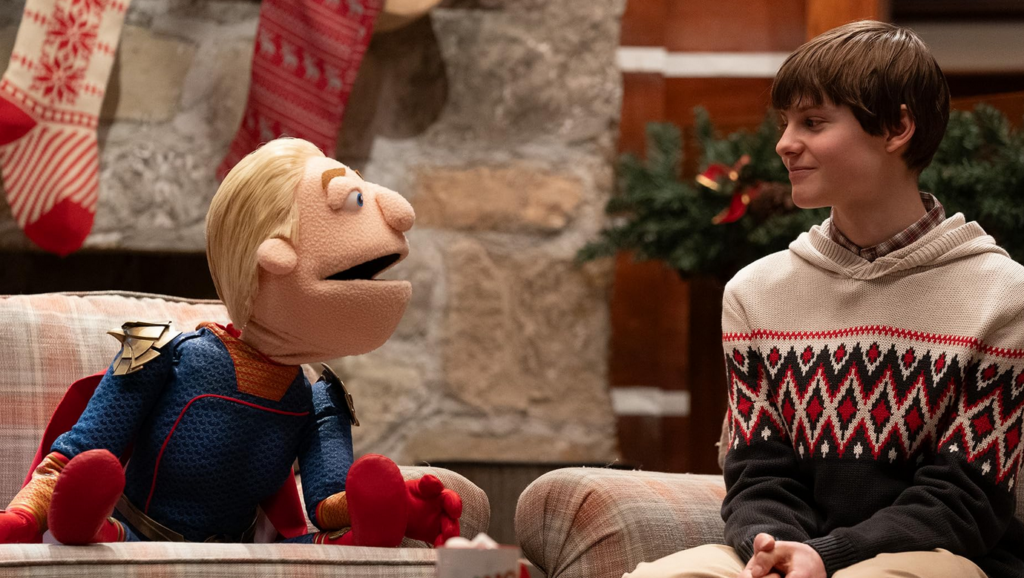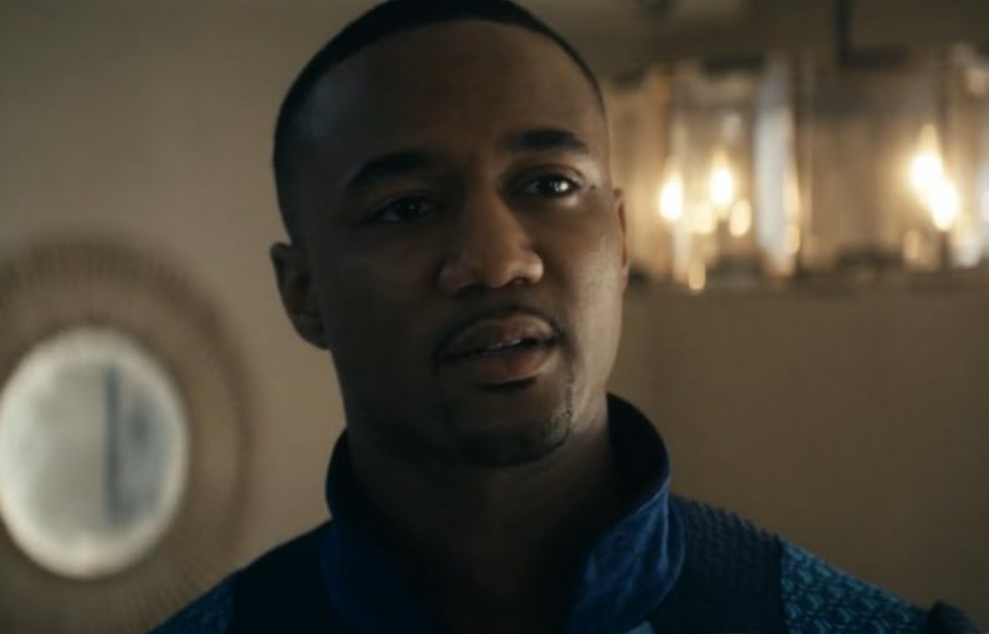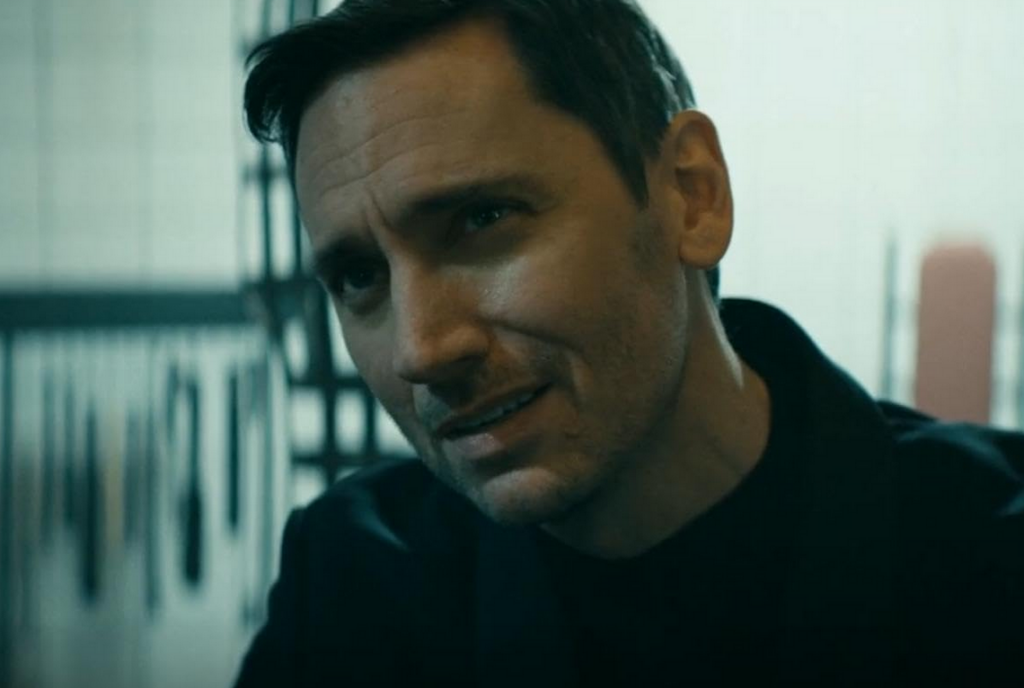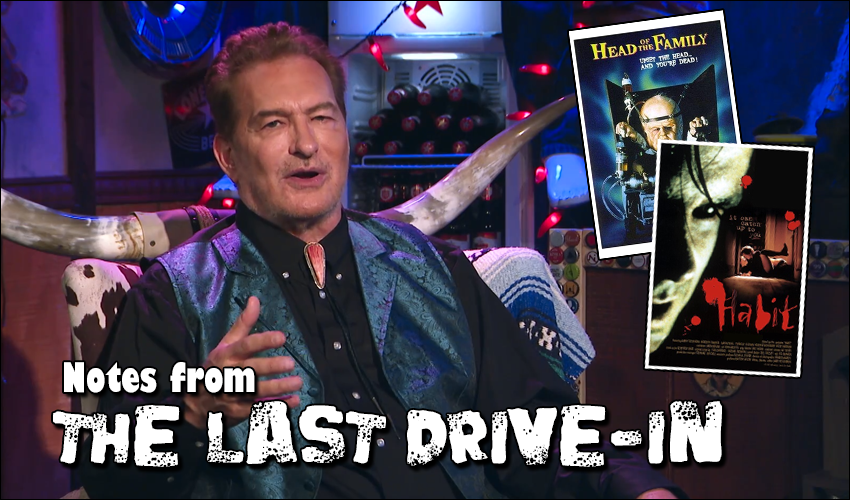
Notes from the Last Drive-In: S4E9 – ‘Head of the Family’ and ‘Habit’
More Videos
Published
2 years agoon
It is 1990s indie night at The Last Drive-In, and we’re here to cover the fun, COVID-be-damned. The review/recap this week might be lacking a little of the usual flair due to my being an incubator for a virus I dodged for two years, but the drive-in never dies, and neither have I. Tonight we get a little bit of east vs. west 1990s indie horror with Head of the Family (1996) and Habit (1997).
So how is the show this week since we gave dads their due last week? What did Shudder share with us this past Friday, June 24th?
Head of the Family (1996)
The first film of the night was the 1996 black comedy Head of the Family, directed by Charles Band. The film was written by Benjamin Carr based on a concept by Charles Band. Adolfo Bartoli served as the director of photography. The music was handled by Richard Band and Steven Morell, which Band’s contribution mostly being the theme. The film stars Blake Adams, Jacqueline Lovell, and Gordon Jennison Noice. The freaky family is played by J.W. Perra, Bob Schott, James Jones, and Alexandria Quinn.
The 1990s indie film follows two lovers, Loretta (Jaqueline Lovell) and Lance (Blake Adams), as they scheme to rid themselves of Loretta’s criminal husband, Howard (Gordon Jennison Noice). Lance soon discovers that the local family of weirdos, the Stackpools, have been secretly entrapping and murdering people under the direction of the head of the family, Myron (J.W. Perra). Lance then tries to manipulate Myron and his siblings (Bob Schott, James Jones, and Alexandria Quinn) into killing Howard, with disastrous results.
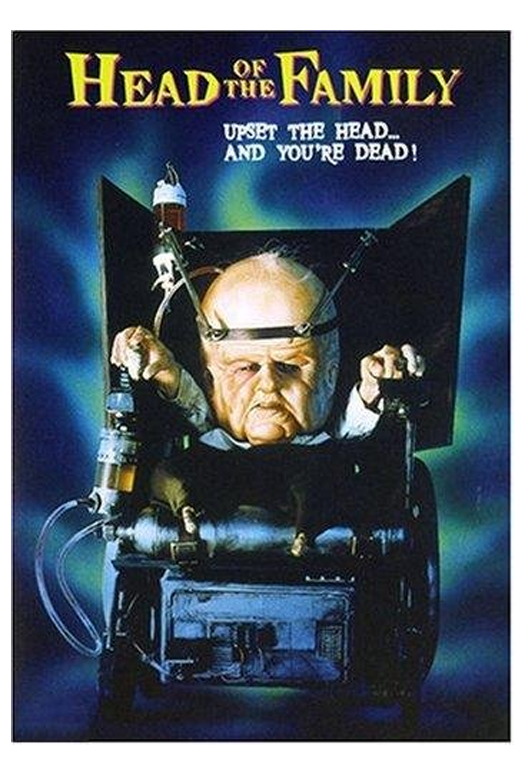
Head of the Family is one of the many bizarre, wonderful films out of Full Moon Entertainment, and for a low-budget mid-1990s film is a pretty quality production. The movie is hilarious and probably the most significant asset to why it succeeds. The concept is weird, and the play of a southern gothic-style crime story with a mutant freak family works surprisingly well. The plot of two lovers planning to rid themselves of a significant other getting in the way of their romance is old hat, but how often is it done with four superpowered siblings, one of which is a giant, wheelchair-bound head?
Except for a little bit of an info dump around the end of the first act (am I legally allowed to refer to “acts” in a Full Moon movie?) by Myron, the writing of the film is whip-smart with fun lines and great back and forth between wildly exaggerated personalities. Even the largely silent Stackpools – Otis, Wheeler, and Ernestina – have their character moments, albeit mostly in silence. The best material, however, comes from Myron’s pseudo-intellectualism contrasted with Lance’s southern-fried con-artist huckstering and Loretta’s scheming hellcattiness.
J.W. Perra is the strongest actor of the bunch, and his long career is an excellent reflection of that. He makes Myron the most fascinating part of the film and does a fantastic job making the smarmy intellectual character my favorite in the bunch. Jaqueline Lovell is also quite fun with her husky southern voice and oversexed energy. As much as I liked Blake Adams as Lance, I think Lovell held her own better against Perra, and their scene is hilarious and disgusting in equal measure.
The film’s pacing is mainly solid, though it does fumble in the third act as Myron’s overly-elaborate “Joan of Arc” stage show scene drags a bit before giving way to a hilariously hasty conclusion. There is just enough B-grade weirdness and trash to keep you going. If there isn’t some funny dialogue flying, there may be a man with a giant head or a gratuitous shot of full-frontal nudity. Sometimes there are all three at the same time. It’s wonderful.
Visually, the movie holds up quite well (sort of), and the forced perspective shots of Myron, the titular “head of the family,” are among the best achievements in the film. Forced perspective can work wonders, and though there are moments when the look can falter, Myron’s introduction is one of the best-looking scenes in the movie. Now, this is also a mid-1990s Full Moon Entertainment movie, so it can also look pretty cheap. I found myself ridiculously entertained by the wall of the bedroom set shaking violently when Otis pins Lance against the wall. Also, the diner location is one of the fakest diners I have ever seen. It’s marvelous.
My biggest gripe with the film may be the music. Full Moon movies tend to have somewhat zippy, bouncy scores that blur together and often are a tonal mismatch with the film itself. Head in the Family is already a farce – it doesn’t need to sound like one, too. There were moments during the movie when I heard the score and wondered if tumblers and acrobats were just off-screen, plying their trade.
Joe-Bobservations on Head of the Family
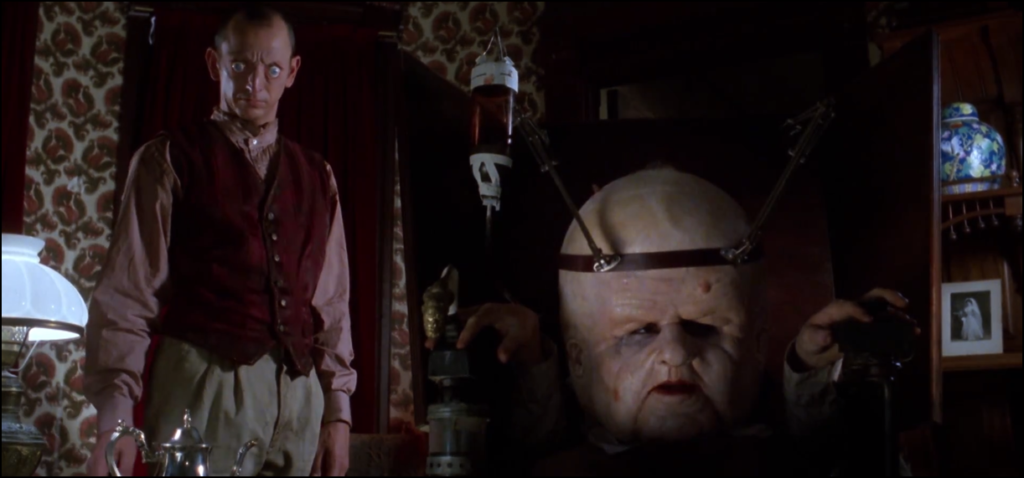
This week was a double header of special guests, pun-intended. Both guests perfectly encapsulated the 1990s indie theme. Charles Band himself dropped by the show to share some of the histories of Head of the Family, the Full Moon Entertainment story, and his thoughts on film in general. Of course, there were plenty of fabulous factoids about the movie, but the real focus was, justifiably, an extended conversation with Charles Band.
Any time Joe Bob sits down and talks with a producer, you have something gold. Charles Band is a director and writer, but he is also a producer, and that may be where his influence is most significant. The role of the producer is sometimes neglected by film writers when it really shouldn’t be. Like Uncle Lloydie, Charles Band has created something special with Full Moon that fills a niche that has become increasingly vital in this world of megacorporate film production. Joe Bob taking the time to sit and pick the brain of one of these producer powerhouses is an excellent opportunity for any filmmaker to learn a thing or two.
With that being said, if you thought Joe Bob Briggs was loquacious, Charles Band can give him a run for his bolo.
Final Thoughts on Head of the Family
As a whole, Head of the Family is a great choice for a Drive-In feature, especially as a 1990s indie. It may be a bit lighter on the blood, but there are breasts, and I would say the Stackpools are technically beasts. For what is a 1996 direct-to-video feature, I was pretty impressed with the quality, and it helps that Charles Band films tend to dig into the camp and low-budget nature and just run with them. With this movie, you get a little sex, and little violence, and a big head. Not bad for a Friday night.
Joe Bob Briggs gave Head of the Family four out of four stars. I think that assessment is pretty fair. This is just that sort of drive-in cheese we need these days. While the film was a lot of fun, some minor issues here and there, mostly the grating music, tell me to be a little more conservative with my score. I give Head of the Family four out of five Cthulhus.

Best Line: “What’s the point of murdering your husband if you can’t fuck in a bed?” – Lorretta
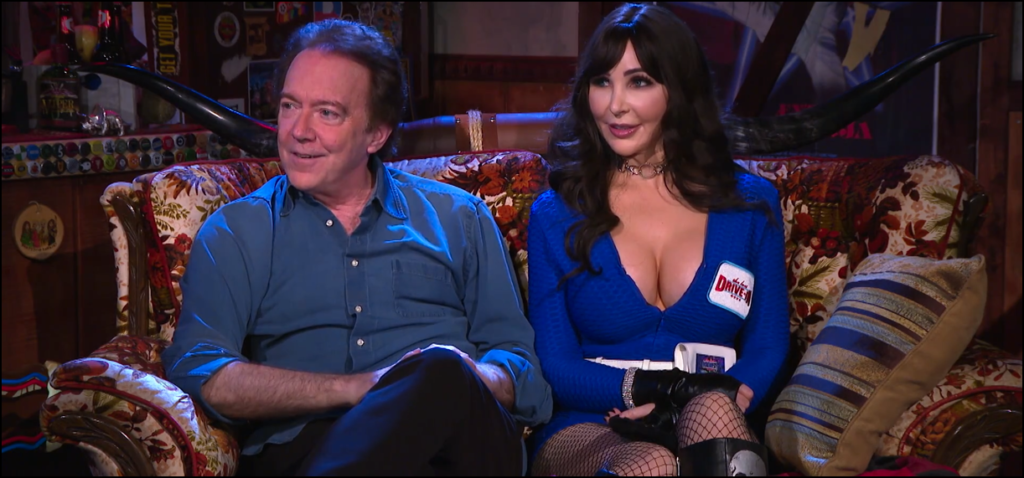
Habit (1997)
The night’s second half featured the 1997 New York indie vampire film Habit. The release date has been listed as 1995 and 1997 across different databases, but most likely, I would say 1997 is the more accurate. If I mention a mid-1990s New York indie film, you might already understand where this movie goes, and you’d be correct. This one is bleak.
The film was written, directed, and edited by Larry Fessenden, who starred. Fessenden is joined by cinematographer Frank G. DeMarco and Geoffrey Kidde handles music duties. The other performers include Meredith Snaider, Aaron Beall, Patrician Coleman, and Heather Woodbury.
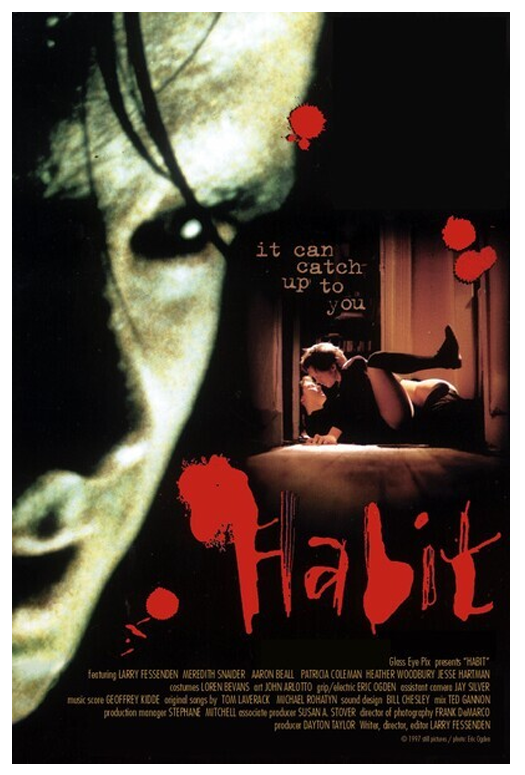
Habit is a variation on Dracula set in mid-1990s New York that follows Sam (Larry Fessenden), a disaffected alcoholic who has lost a father and his long-time girlfriend. At a friend’s Halloween party, he encounters the mysterious Anna (Meredith Snaider), who pulls him into a world of kinky sex which begins to unravel his life, much like his other addictions have before.
Habit is a bleak film but also is an excellent take on a vampire story. There are some direct references to Dracula here and there. Still, the film ultimately strikes out on its own to deliver a fascinating story about a man substituting one vice for another and the self-destruction that comes with it. The metaphor is obvious but very well executed, and the real horror doesn’t come from the vampire but rather from watching a man self-destruct and failing to do anything about it until it is too late. Sex with Anna is too exciting, too addictive, and even though Sam sees the toll it takes on his life and relationships, he cannot stop, even giving in during a struggle for life and death.
Fessenden is a fascinating character who has been a staple of the New York independent film scene for decades, and this is the work of a seasoned filmmaker. He is also a naturalistic performer, and while one may smirk at him writing and directing a film where he has sex with a manic-vampire-dream-girl, he conveys in his acting that it takes its toll. He has a presence, and at times I found myself drawing parallels to Jack Nicholson in his performance. The vaguely-autobiographical choices in characterization and performance lend a rawness to the film, which it benefits from.
The beautiful and seductive Anna is the most critical role in the film. For all the importance of Sam’s self-destructive choices, we need to buy into the idea that this blood-sucking woman is worth it, and Meredith Snaider, in her only film role, absolutely pulls it off. Snaider’s androgynous appearance and the voracious physicality of her performance establish the danger and temptation of Anna. She can go from charming to menacing at a moment’s notice, but it doesn’t matter to Sam or the audience. Everyone has a little kink, and Anna might be enough to draw it out of most viewers. What is a little bite in the throes of passion, anyway?
The acting choices of the supporting cast are generally excellent and nuanced, lending the film a realistic feel despite the supernatural theme. With that said, only one performance of the bunch frequently frustrated and confused me, and that was Aaron Beall as Nick, one of Sam’s friends. With that said, I do not feel like Beall did a poor job, but I do feel he was the wrong choice for the role, especially given an absurdly on-the-nose monologue in the film’s final act. The minute he showed up in the movie, I couldn’t help but say, “ah, so here is the theater kid.” If you know, you know.
The writing is strong as a whole with good dialogue, but the last act falters with one of the most overwritten monologues I’ve seen in recent memory. The film had done such an incredible job laying out its themes and metaphor using the language of cinema that to have Nick just rattle them out to a strung-out paranoid Sam also felt insulting to me. It may be that the hamhandedness of this moment colored my perspective on Beall’s acting. It was a real sour spot for me.
The film’s best moments may be those removed from New York City, however, as the friends go to a beach house and we get a glimpse of a better, more free Sam. A lovely scene on the shore gives us a look at what Sam could be if he could kick his habit. Still, Anna’s menace in the background, combined with the most traditional horror scene in the film, illustrates the underlying inescapability of his addiction.
The film’s aesthetics are particularly appealing to me. The sort of grungy, gothic New York City, devoid of the usual landmarks, looks fabulous. For being a film draped in shadows, the film handles light far better than billion-dollar franchises today. The film has such tremendous visual quality that while it is in color, I would love to see a black and white version. That might make it the ultimate 1990s indie vampire movie.
Joe-Bobservations on Habit
The second half of 1990s indie night featured an extended interview with the charming Larry Fessenden, who is just a cool, kind of weird dude. He has such a low-key and professional attitude to the craft for someone so admired and ingrained in the independent film scene in New York. Whereas Charles Band has a more slick and west coast sensibility to his cadence, Larry exudes an east coast vibe.
The interview segment was fantastic, and Fessenden was appropriately cagey regarding interpretations of his movies. Much hay is made about meaning and analysis when it comes to films like Habit. Hell, I’ve indulged in that in this very review. But there is something exhilarating about having the filmmaker commit to no answer and just encouraging whatever interpretations are out there.
Final Thoughts on Habit
Habit is on my shortlist of truly great vampire films. This 1990s indie film’s quality extends far past the novelty of the setting and theme. The performances are strong, and barring a significant misstep, the writing is excellent. I really found myself drawn in by the exploration of vampirism and addiction. In a genre as overstuffed as vampire movies, Habit is a standout.
Joe Bob Briggs gave Habit three and a half out of four stars. I think he could have bumped it up a half-star, personally. I loved it, but that third-act monologue harshed my buzz, as they said in the 1990s. I give Habit four out of five Cthulus.

Best Line: “I suspect that the less you know about me, the longer you’ll stay interested.” – Anna
Haunted MTL Drive-In Totals
As always, we have the official Drive-In Totals from Shudder.
"Whole lotta licking going on in this one. 👅 Whole lotta aardvarking in tonight's second feature, if you know what I mean and I think you do. 😚#TheLastDriveIn pic.twitter.com/GrZ2uLSrmq— Shudder (@Shudder) June 25, 2022
Oh yeah, that one.#TheLastDriveIn" pic.twitter.com/17cNKDPmAi— Shudder (@Shudder) June 25, 2022
We also have my totals. As I was sick with COVID (and still am as I write this review), I do not have as many notes to work from. Hell, I didn’t even live-tweet the show this week, either.
- 5 Question Digressions
- 11 Utterances of “Thee-ate-er”
- 12 Puppet Master Movies
- 24 Speaking Roles over 4 Days (Head of the Family)
- 30 Full Moon scripts by Benjamin Carr
- Gratuitous Sets
- Gratuitous New York Grunge
- Gratuitous Talking Heads Parody
- Surprise Yuki
- Surprise Horniest Drive-In Yet
- Banking Joking
- Necrophilia Joking
- Slurp Fu
- Clipboard Fu
- Full Moon Fu
- Head Rolls
- Darcy Cosplay: Loretta
- John Brennan Cosplay: Otis
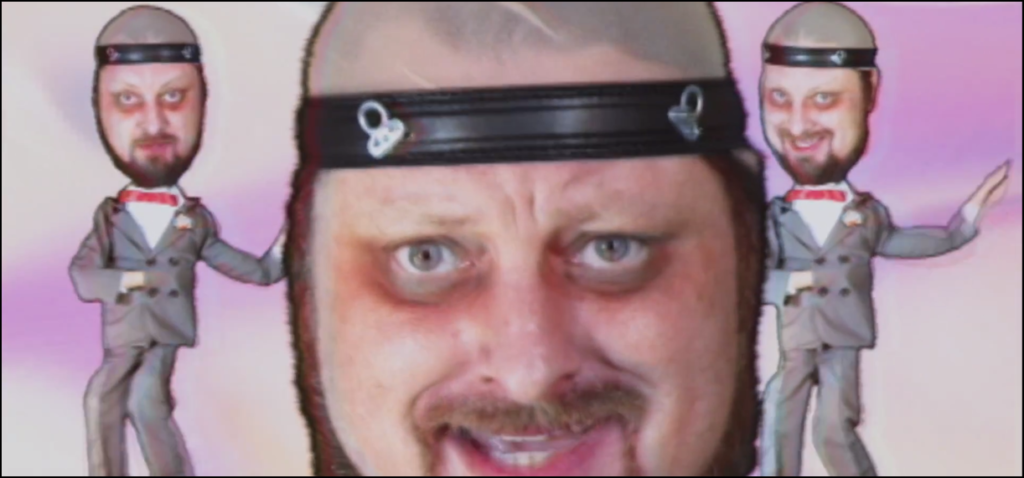
Episode Score for The Last Drive-In S4E9 – Head of the Family and Habit
I think that 1990s indie night was a compelling theme this week, and it certainly helped that I loved both films for very different reasons. There wasn’t much in the way of gimmicks in the host segments either. Not that gimmicks aren’t hilarious and welcome, but sometimes Joe Bob just chilling with the mutant fam, talking about movies, is welcome enough. The film had a sub-theme of east vs. west 1990s indie double feature that was also pretty impressive, and I think that Head of the Family and Habit were good representations of these two different spheres of film.
Combine two good movies with two great interviews with two independent film icons, and you have a good night at the drive-in. I didn’t even get into the Talking Heads parody in the night’s first half. I would give this episode of The Last Drive-In four and a half out of five Cthulhus.

And that is it for us this week. Did you enjoy 1990s indie night? Let us know.
Please join us on Twitter next Friday as we live-tweet with the rest of the Mutant Fam during The Last Drive-In with Joe Bob Briggs. I should be over this horrid virus by then, I hope.
David Davis is a writer, cartoonist, and educator in Southern California with an M.A. in literature and writing studies.

You may like
We have come now to the finale of season four of The Boys. And while it didn’t have the literal blood fireworks I wanted, someone did get ripped in half in the air. So, that’s pretty close.
As a note, I will try to avoid spoilers as much as possible. This ending was a hell of a gut punch that should be experienced as blindly as possible. That being said, I will not be able to avoid spoilers and still give a full legitimate review. Proceed at your own risk.
The story
The main storyline for this episode is the attempted assassination of President-Elect Robert Singer. The Boys join forces with the Secret Service to protect him. But, as we learned last episode, Annie has been replaced with a shapeshifter. A shapeshifter that was welcome not just into Hughie’s anus, but into the protective bunker in which the President-Elect is hiding.
What worked
The first thing I want to discuss about this episode is the ending. But we need to do this carefully.
The important thing here is that the ending breaks your heart on so many levels. So many terrible things are happening to characters that it’s almost hard to keep track. And each moment is significant to each character.
I cannot give a specific example. But no matter who your favorite character is, you’re going to weep for them.
Unless your favorite character is Sage. And this is the next thing that made this episode so fantastic.
I don’t think I’m spoiling anything to say that Sage’s plans worked out exactly as she wanted them to. And she got exactly what she wanted.
What she wanted wasn’t power. It wasn’t money or fame or vengeance. It wasn’t to win the love of anyone. She just wanted to see if she could do it.
That is a terrific, terrifying motivation! Because all she wants is to play a massive game of chess with people as pieces. She doesn’t care about anyone. She just wants to see how many people she can manipulate. She just wants to set things on fire to see if she can.
Fantastic. A plus villain work.
The next thing I want to discuss is a cornerstone of the whole series.
The morality of The Boys shifts through the series. While it’s very much a battle to save the world from overpowered super monsters, it’s also a battle for the souls of our real heroes. And in that battle, there are two warring factors. We have Hughie, always trying to bring everyone up to a better level. And we have Butcher, who has no problem at all hitting rock bottom with a shovel in hand to do some more digging.
In this episode, we saw almost every member of The Boys challenged. Will they rise to their higher angels, or sink with their demons?
On a similar note, I am so glad that the writers kind of addressed my issues with Annie. They did this by having the shapeshifter get right into her face and accuse her of thinking that she’s better than everyone.
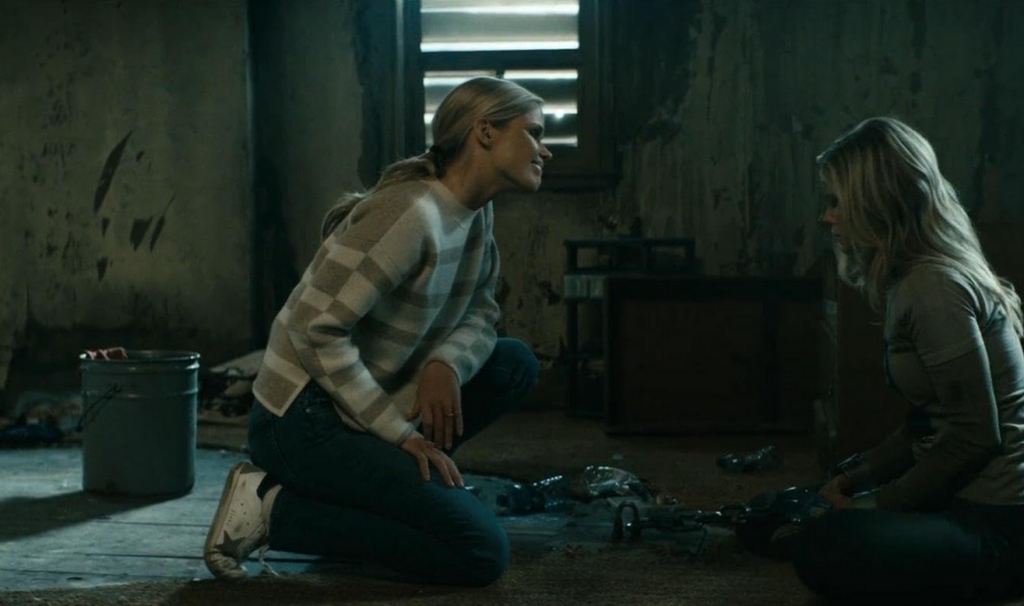
While that was devastating for the character, it was a little cathartic for those of us who felt like Annie was a little too good of a good guy.
What didn’t work
This is a small matter, but it is an issue that I want to address. After Annie finds out that Hughie slept with her doppelganger, she is furious at him.
In addition to this being unfair, it’s also a very cliche element to add. In almost every instance of a lookalike in fiction, there’s a moment where the love interest of the victim is fooled. Or almost fooled. And it’s always the same fight. It’s just played out and predictable. I’m just glad that it didn’t last very long.
Now that we’ve come to the end of the season, I can officially say that it was amazing. The story was deep and rich. The special effects were a stomach-turning good time. The character development was spot-on and satisfying. And, of course, it left me just about gagging to see what happens next. Unfortunately, it looks like we’ll have a bit of a wait. Because as of right now, the fifth season isn’t expected until 2026.

We’ve reached the second to last episode of The Boys, season four. And, as is appropriate for the penultimate episode of any show, things have to get a lot worse before they can get better.
Let’s discuss.
The story
Christmas is coming, and the whole world is getting ready. Ryan, despite being very clear that he didn’t want to appear on any TV shows or movies, has been strong-armed into participating in a Vought puppet Christmas special. He draws the line, though, when asked to sing about turning one’s parents in if they start talking about woke things.
Meanwhile, The Boys are trying to keep each other together. Butcher decides to take Sameer to the rest of the team. He also gets Frenchie out of prison, hoping they can make the Sup virus necessary to finally take down Homelander. Instead, this decision means disaster for one member of the team.
What worked
I first want to talk about Ryan’s speech near the end of the episode. Because it was exactly the moral of this whole story.
Ryan’s dad is a monster. His stepdad is also kind of a monster. But Ryan is a good kid. He cares about people, about family. And while he loves Homelander and Butcher, he doesn’t want to be like them.
Even better, this speech sounded like something a kid would say. Ryan didn’t open his mouth and start sounding like a college student all of a sudden. He sounds like a kid who misses his mom and wants to live up to the good standards she set for him. And I think that’s terrific.
Speaking of Homelander, he shot himself in the foot in this episode. I said earlier in the season that his hubris was going to be his downfall, and I was right. Without Sage, he just has the same weaknesses he’s always had. He’s going to fail because he just isn’t clever enough or patient enough to succeed.
Without Sage, I think a win is in the bag for The Boys. This isn’t to say that Homelander by himself isn’t dangerous. It’s just that he’s more like a wildfire than a controlled burn. He’s going to cause a lot of damage, but not get anything he wants out of it.
More’s the pity for him and everyone else who has to share his world.
Finally, I am thrilled with A-Train’s redemption story. I love that he wants to be a good person not to save himself, but to be a good person. His honest, pure and warm reaction to that little kid smiling at him in the last episode was heartwarming. It changed him in a moment, bringing to light a goodness that he’s been keeping under wraps for a long time.
This, along with Ryan’s courageous speech, proves once again what The Boys does so well. Yes, it’s gruesome. Yes, there’s blood and balls and batshit events. Yes, someone occasionally gets ripped in half. But there is a true human goodness in the story. One that we catch glimpses of. There are good people among the monsters. There is hope for redemption.
What didn’t work
Of course, so few things in this life are perfect, and this episode was no exception. For instance, I was irritated by the insinuation that Butcher cheated on his wife.
That just doesn’t make any sense. We’ve seen flashbacks of Billy and Becca. They were happy. He was happy. He was head over heels for her. And I don’t think it’s realistic or necessary for the character to throw in that he cheated. It does nothing to add to the story, it’s just a weird and offputting moment.
Doesn’t Butcher have enough to hate about himself? Can’t we just give him that at least he was a good husband?
Finally, I kind of hate that we ended up with Annie being caught. It’s just cliche, which is something I don’t normally say about this show. It feels lazy unless they do something very clever with it in the last episode. Which, I suppose, they might.
Next up is the season finale. And with this season being as insane as it has been, I’m expecting nothing short of bloody fireworks. And I mean literal fireworks of blood. At this point, would it surprise anyone?
 (4 / 5)
(4 / 5)
Episode six of The Boys was one of the most surprising episodes of the series so far. And that is certainly saying something. Because this season has so far been bonkers.
The story
Our episode today revolves around a party at Tek Knight’s lovely mansion. Yes, it does look just like Wayne Manor.
The Boys know that Tek Knight is working with Homelander on something, but they don’t know the details. So they decide to send Hughie in to bug the mansion.
Because that’s worked so well the other two times he’s tried to hide a bug!
It should surprise no one that this time goes no better. Hughie finds himself in Tek Knight’s basement. And by that I mean his BDSM dungeon.
Meanwhile, the party upstairs is no less disturbing. Homelander and Sage are trying to convince some well-off political donors to support a cue after the election. When pressed for details on his plan, Homelander freezes. He looks to Sage for help, but she wasn’t recently shot in the head and still in the junk food stage of her healing.
Fortunately, or unfortunately depending on your point of view, Neuman jumps in and saves the day.
What works
If I’m going to say one thing about this episode, it didn’t hold back at all. I didn’t expect them to show a character masturbating, sitting their bare behind on a cake, or spraying breastmilk into someone’s face. But every time I thought they’d cut the scene and let something be left to our imagination, they did not do that.
This is a dangerous move. Whenever you show the monster, you run the risk of them not being scary enough, or gross enough. As Stephen King says in Danse Macabre, to leave this sort of thing to the imagination if the reader makes things so much worse. So when they finally experience the monster, they might say that this isn’t so bad. It could have been so much worse.
But in this case, they managed to avoid that by making the scenes, especially the ones in Tek Knight’s dungeon, so much worse than I imagined it would be.
What doesn’t work
While this was a deeply disturbing episode in many ways, there was one really innocent and sweet moment.
And yes, I did have a problem with it.
Confronted by Firecracker, Annie decides to apologize for spreading rumors about her when they were kids. She tells her that she is genuinely sorry.
And I believe her. I don’t think Firecracker did, but I did.
So why is this an issue? Because I’m starting to think that Annie is maybe too nice. She is too good.
I know that Annie is our good guy. But every one of the other good guys has flaws. Hughie let his pride get in the way and took Temp V. MM hid himself from his daughter instead of teaching her to work through her emotions. Kimiko is far too closed off and has a hard time trusting others. Frenchie numbs himself with drugs. And well, what hasn’t Butcher done?
It is unrealistic that Annie is just so kind and so flawless. We all have shadows in our personalities. We all have weaknesses, we all mess up. We all do things we wish we could take back. The fact that Annie doesn’t seem to have anything like that is not just unrealistic. It’s infantilizing.
Give her some deep dark secrets. Give her something real to regret.
This was a shocking episode, even for someone fairly jaded like me. I wasn’t expecting the sort of weird sexual depravity, though I guess maybe I should have seen it coming. It was dark, upsetting, tense, and funny as hell. And with just two episodes left in the season, I can imagine the stakes are only going to get higher.
 (4 / 5)
(4 / 5)
By the way, if you like my writing you can get my short story, Man In The Woods, on Smashwords and Amazon.

